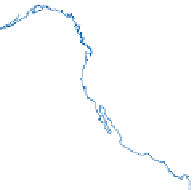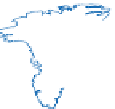Geoscience Reference
In-Depth Information
continents cover only 29 per cent of the surface. The
difference is explained by the presence of
epicontinental
seas
, such as the North Sea, the Black Sea, parts of the
Mediterranean and Hudson Bay, on continental crust
Continental architecture consists primarily of stable
ancient
cratons
swathed in the remnants of six to eight
orogens of various younger ages (
Figure 10.19
).
Cratons
are stable cores around which continents form and reform
with only minor 'bruising', contrasting with the high
geothermal flux, landsurface elevation and geomorphic
activity of the Cenozoic orogens. Despite their stability
and location, usually over cool spots, the cratons have
endured sustained erosion since their Archaean or
Proterozoic formation and are now areas of modest overall
and relative relief. Between stable cratons and unstable
orogens, epeirogenesis and isostatic adjustments create
lesser, long-term disturbances of continental lithosphere.
Their principal effect is to adjust gravitational energy
inputs and hence erosion rates, with elevated plateaux
forming sediment sources and subsidence zones creating
basins which act as terrestrial sediment traps.
What are the consequences of rifting, which initiates
the Wilson cycle and eventually forms new oceans, for the
continents themselves? Emerging mid-ocean rifts may
propagate across ocean-continent boundaries. The East
African rift, for example, is the landward extension of the
triple junction formed with the Red Sea and Gulf of Aden.
If it fails to propagate further and develop into a full mid-
ocean ridge system it will join a long list of
aulacogens
.
Although classed as failed rifts, they still play a significant
role in continental architecture, often forming major
topographical depressions which channel world-scale
rivers and their sediment fluxes. The North Sea basin and
Rhine graben extension is another example. Continental
rifting in which significant crustal extension or thinning
occurs has other consequences. Asymmetrical rifting
may generate
basin and range
topography, best seen
between the Sierra Nevada and Rocky Mountain ranges
of the western United States (
Plate 10.5
),
and may be
accompanied by basaltic extrusions.
Effusive
flood basalts
inundate the existing land surface
and may extend over large areas. The Mesozoic break-up
of Pangaea generated large basalt flows near rifted margins
LONGITUDE
60°
60°
120°
180°
120°
0°
80°
80°
60°
60°
40°
40°
20°
20°
0°
0°
20°
20°
Mesozoic-Cenozoic orogens up
to 200 Ma old
Late Palaeozoic (Variscan) orogens
c. 300 Ma old
Mid-late Palaeozoic (Caledonian)
orogens c. 400 Ma old
40°
40°
60°
60°
Stable cratons over 1.5 Ga old
60°
120°
180°
120°
60°
0°
Figure 10.19
Global distribution of cratons and Phanerozoic orogens. Most intervening areas (green) are sedimentary basins.
Sources: After Fowler (1990) and Smith (1982)



































































































































































































































































































































































































































